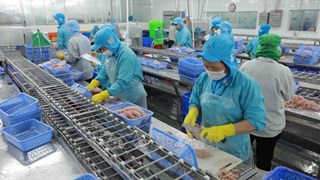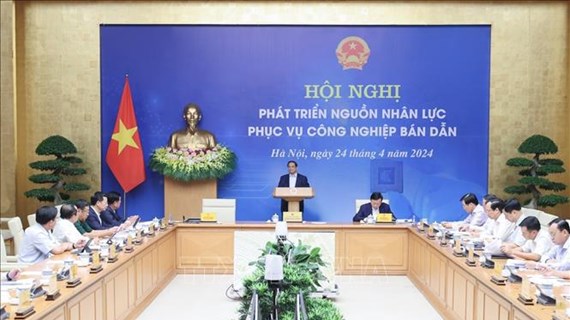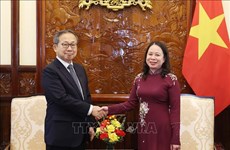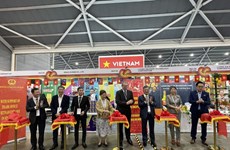An Giang aims to tap huge potential
The Mekong Delta province of An Giang, which shares nearly 100
kilometres of its border with Cambodia, has enormous potential for
socio-economic development, the Vietnam Investment Review (VIR)
reported.
The Mekong Delta province of An Giang, which shares nearly 100
kilometres of its border with Cambodia, has enormous potential for
socio-economic development, the Vietnam Investment Review (VIR)
reported.
With two international border gates - Tinh Bien and Vinh Xuong, and two national border gates - Khanh Binh and Vinh Hoi Dong, the province is regarded as a major economic and trade hub, connecting the three major cities of Ho Chi Minh City, Can Tho and Phnom Penh and serves as an important gateway for trade exchanges among localities in the delta region and Cambodia and other ASEAN member countries.
An Giang border gate economic zone covers 256.8 square kilometres, and is divided into three functional zones: 99 sq.km Vinh Xuong border economic zone (EZ), 92 sq.km Tinh Bien border EZ, and 74 sq.km Khanh Binh border EZ.
In the previous years, the province has concentrated on calling for investment into infrastructure to help fostering tourism and border economic development.
Residents in border areas have been supported in terms of agricultural, industrial, trade, services, and tourism development to gradually raise income levels, narrowing the gap in development between border residents and those in other parts of the province.
Thanks to its location at the mouth of the Mekong River, An Giang possesses ideal conditions for agricultural development, particularly rice, cereals and fresh-water fish. Rice is one of An Giang’s staples, covering nearly 650,000 hectares with an average yield of 6.5 tonnes per hectare.
An Giang now ranks second countrywide in paddy rice production at around four million tonnes per year. Its rice has made inroads in countries around the globe and each year brings the province several hundred million US dollars in export value. Last year, rice brought the province 203 million USD in export value.
The province also has advantages in growing cereals such as corn, groundnuts, sesame and Indian taro which have delivered even better earnings than rice. Cereals now cover more than 60,000ha in the province and this figure is increasing.
Seafood was established as the province’s spearhead sector with basa and tra fish identified as the province’s strategic products. The province is home to about 2,000ha of aquacultural area of which 1,100ha is dedicated to tra fish farming.
Seafood output comes to about 287,000 tonnes, of which nearly 230,000 tonnes are basa and tra fish, a huge material source for export processing of businesses based in An Giang and other surrounding locations.
Last year, An Giang exported 170,000 tonnes of seafood, generating 440 million USD in the export value.
In terms of livestock breeding, An Giang hosts large cattle and poultry herds, with 100,227 cows, 137,805 pigs, and 3.95 million poultry. Specifically, cattle herds are expanding quickly as more local households look at raising cows as an effective way to promote their household earnings.
The province also has huge tourism potential as it is home to many famous cultural and historical sites, such as the Cam Mountain, Tra Su indigo forest in Tinh Bien district, Oc Eo archeological site in Thoai Son district, and Tuc Dup in Tri Ton district.
The province also attracts visitors through distinct local events such as the Khmer bull fighting festival in Tinh Bien and Tri Ton districts, and the Islamic festival of Ramadan held by the local Cham people.
The province’s tourism sector has been developing robustly in recent years. Travel companies have constantly invested in improving services and promoting its image in key domestic and foreign markets.
Last year, An Giang received nearly 5.5 million visitors, generating more than 315 billion VND (15 million USD) in revenues. In the first nine months of this year, 5.4 million tourists visited to the province’s tourism attractions, bringing over 273 billion VND (13 million USD) in revenues.
This diverse potential has proven An Giang to be a promising land for domestic and foreign investors, according to the VIR.-VNA
With two international border gates - Tinh Bien and Vinh Xuong, and two national border gates - Khanh Binh and Vinh Hoi Dong, the province is regarded as a major economic and trade hub, connecting the three major cities of Ho Chi Minh City, Can Tho and Phnom Penh and serves as an important gateway for trade exchanges among localities in the delta region and Cambodia and other ASEAN member countries.
An Giang border gate economic zone covers 256.8 square kilometres, and is divided into three functional zones: 99 sq.km Vinh Xuong border economic zone (EZ), 92 sq.km Tinh Bien border EZ, and 74 sq.km Khanh Binh border EZ.
In the previous years, the province has concentrated on calling for investment into infrastructure to help fostering tourism and border economic development.
Residents in border areas have been supported in terms of agricultural, industrial, trade, services, and tourism development to gradually raise income levels, narrowing the gap in development between border residents and those in other parts of the province.
Thanks to its location at the mouth of the Mekong River, An Giang possesses ideal conditions for agricultural development, particularly rice, cereals and fresh-water fish. Rice is one of An Giang’s staples, covering nearly 650,000 hectares with an average yield of 6.5 tonnes per hectare.
An Giang now ranks second countrywide in paddy rice production at around four million tonnes per year. Its rice has made inroads in countries around the globe and each year brings the province several hundred million US dollars in export value. Last year, rice brought the province 203 million USD in export value.
The province also has advantages in growing cereals such as corn, groundnuts, sesame and Indian taro which have delivered even better earnings than rice. Cereals now cover more than 60,000ha in the province and this figure is increasing.
Seafood was established as the province’s spearhead sector with basa and tra fish identified as the province’s strategic products. The province is home to about 2,000ha of aquacultural area of which 1,100ha is dedicated to tra fish farming.
Seafood output comes to about 287,000 tonnes, of which nearly 230,000 tonnes are basa and tra fish, a huge material source for export processing of businesses based in An Giang and other surrounding locations.
Last year, An Giang exported 170,000 tonnes of seafood, generating 440 million USD in the export value.
In terms of livestock breeding, An Giang hosts large cattle and poultry herds, with 100,227 cows, 137,805 pigs, and 3.95 million poultry. Specifically, cattle herds are expanding quickly as more local households look at raising cows as an effective way to promote their household earnings.
The province also has huge tourism potential as it is home to many famous cultural and historical sites, such as the Cam Mountain, Tra Su indigo forest in Tinh Bien district, Oc Eo archeological site in Thoai Son district, and Tuc Dup in Tri Ton district.
The province also attracts visitors through distinct local events such as the Khmer bull fighting festival in Tinh Bien and Tri Ton districts, and the Islamic festival of Ramadan held by the local Cham people.
The province’s tourism sector has been developing robustly in recent years. Travel companies have constantly invested in improving services and promoting its image in key domestic and foreign markets.
Last year, An Giang received nearly 5.5 million visitors, generating more than 315 billion VND (15 million USD) in revenues. In the first nine months of this year, 5.4 million tourists visited to the province’s tourism attractions, bringing over 273 billion VND (13 million USD) in revenues.
This diverse potential has proven An Giang to be a promising land for domestic and foreign investors, according to the VIR.-VNA













